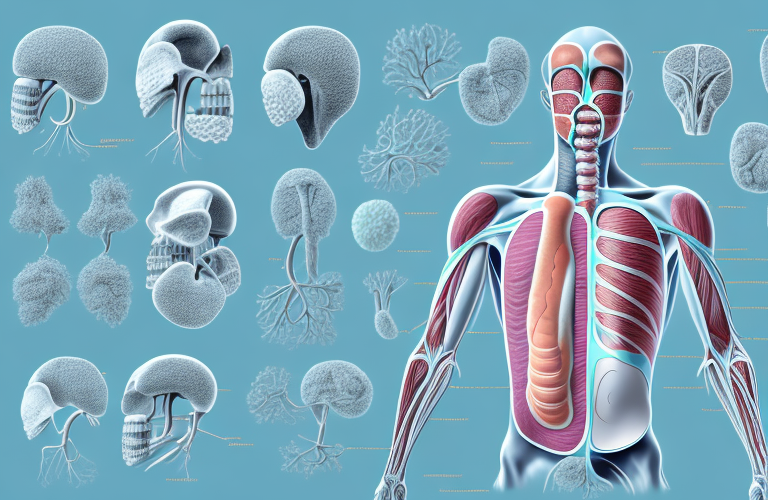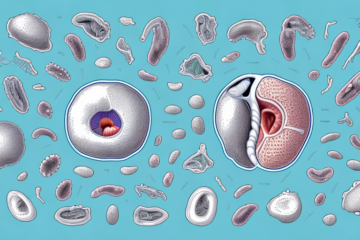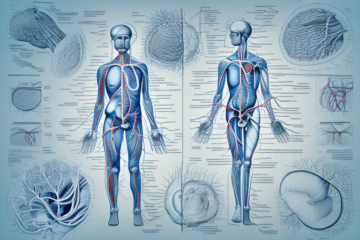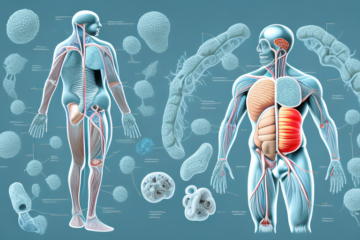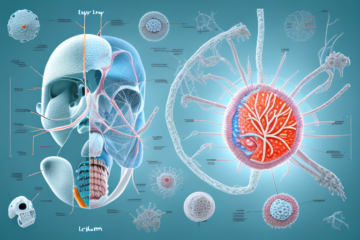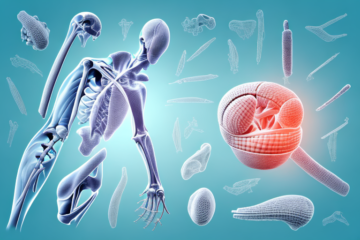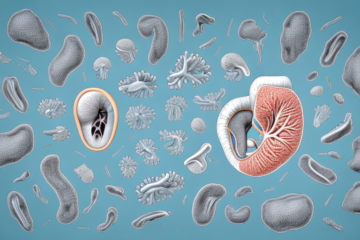The human respiratory system is a complex network of organs and tissues that work together to facilitate the exchange of oxygen and carbon dioxide. Among the vital components of this system are the bronchi, which are often overlooked despite their crucial role in respiratory function. In this article, we aim to provide a comprehensive overview of bronchi, their anatomy, function, and various associated conditions.
Understanding the Respiratory System
Before we dive into the specifics of bronchi, let’s briefly revisit the respiratory system as a whole. The respiratory system is responsible for taking in oxygen and expelling carbon dioxide. It comprises the lungs, trachea, bronchi, bronchioles, alveoli, and diaphragm. All of these components work together to facilitate breathing. The lungs are the primary organs of respiration and are responsible for exchanging gases with the atmosphere.
The respiratory system is also closely linked to the cardiovascular system. Oxygenated blood from the lungs is transported to the heart, which then pumps it to the rest of the body. Similarly, carbon dioxide produced by the body’s cells is transported back to the lungs to be exhaled. This exchange of gases is essential for maintaining the body’s pH balance and ensuring proper cellular function. Additionally, the respiratory system plays a crucial role in regulating the body’s temperature and protecting against harmful substances in the air.
What are Bronchi?
Bronchi are the large, hollow tubes that connect the trachea to the lungs. They are the main passageways through which air enters and exits the lungs. The trachea, which is commonly referred to as the windpipe, divides into two bronchi, each of which then divides further into smaller bronchioles. Bronchi form the bronchial tree, which is responsible for distributing air throughout the lungs.
The bronchi are lined with cilia, which are tiny hair-like structures that help to move mucus and other particles out of the lungs. This is an important function of the bronchi, as it helps to prevent infections and other respiratory problems. However, exposure to certain irritants, such as cigarette smoke, can damage the cilia and impair their ability to function properly.
In some cases, the bronchi can become inflamed and narrowed, a condition known as bronchitis. This can cause symptoms such as coughing, wheezing, and shortness of breath. Chronic bronchitis, which is characterized by a persistent cough that lasts for at least three months out of the year for two consecutive years, is often seen in people who smoke or who are exposed to air pollution or other irritants on a regular basis.
Anatomy of the Bronchi
The bronchi are composed of three layers of tissue: the cartilage layer, the muscular layer, and the mucosal layer. The cartilage layer provides structural support, while the muscular layer allows for the contraction and relaxation of the bronchi, which plays an important role in regulating air flow. The mucosal layer is lined with cilia, which help to trap and remove foreign particles from the air before it reaches the lungs.
In addition to their structural and functional roles, the bronchi also play a crucial role in the immune system. The mucosal layer contains specialized immune cells, such as lymphocytes and macrophages, which help to identify and eliminate harmful pathogens that enter the respiratory system. This immune response is essential for protecting the body from infections and diseases.
Types of Bronchi
The bronchi are divided into two primary types: the primary bronchi and the secondary bronchi. The primary bronchi are the largest and arise from the trachea. They are then further divided into the secondary bronchi, which divide further into tertiary bronchi and eventually bronchioles. The bronchioles then lead to the alveoli, which are responsible for gas exchange.
The primary bronchi are also known as the main bronchi and are responsible for carrying air to the lungs. The secondary bronchi, on the other hand, are responsible for carrying air to the lobes of the lungs. Each lobe of the lungs has its own secondary bronchus. The tertiary bronchi are responsible for carrying air to the bronchioles, which are the smallest airways in the lungs. The bronchioles are responsible for regulating airflow and are surrounded by smooth muscle, which can contract or relax to control the amount of air that enters or leaves the lungs.
Bronchial Tree: Structure and Function
The bronchial tree is the branching system of air passages that extend from the trachea to the smallest bronchioles. The bronchial tree plays a vital role in facilitating the movement of air into and out of the lungs. The branching structure of the bronchial tree allows for the distribution of air to different regions of the lungs, ensuring that each alveolus receives sufficient oxygen for gas exchange.
In addition to its role in gas exchange, the bronchial tree also serves as a defense mechanism for the respiratory system. The lining of the bronchial tree contains cilia, which are tiny hair-like structures that move in a coordinated manner to sweep mucus and foreign particles out of the airways. This helps to prevent infections and other respiratory illnesses.
How do Bronchi Work?
The bronchi work by contracting and relaxing their smooth muscle layers to regulate the flow of air in and out of the lungs. The mucous membranes lining the bronchi trap and remove foreign particles from the air to prevent them from entering the lungs. The cilia lining the bronchi also help to move the mucus out of the lungs.
In addition to their role in regulating airflow and removing foreign particles, the bronchi also play a crucial role in the immune system. The bronchi contain immune cells, such as macrophages and lymphocytes, which help to identify and destroy harmful pathogens that may enter the lungs.
However, the bronchi can also be affected by various diseases, such as bronchitis and asthma. In these conditions, the smooth muscle layers of the bronchi can become inflamed and constricted, leading to difficulty breathing and other respiratory symptoms.
Role of Bronchi in Breathing
The bronchi play a critical role in breathing by providing a conduit through which air can enter and exit the lungs. They also help to regulate the flow of air and ensure that the alveoli receive sufficient oxygen for gas exchange. Any disruption in the normal functioning of the bronchi can result in respiratory difficulties and significantly impact a person’s quality of life.
In addition to their role in breathing, the bronchi also have an important immune function. They are lined with cells that produce mucus and have tiny hair-like structures called cilia that help to trap and remove foreign particles, such as bacteria and viruses, from the airways. This helps to prevent infections and keep the respiratory system healthy.
Common Bronchial Conditions and Diseases
Some of the most common bronchial conditions include bronchitis, asthma, and chronic obstructive pulmonary disease (COPD). Bronchitis is a condition characterized by inflammation of the bronchi, which often leads to coughing and difficulty breathing. Asthma is a chronic respiratory condition that can cause narrowing of the bronchioles, leading to wheezing and shortness of breath. COPD is a progressive lung disease that makes it difficult to breathe and can eventually lead to respiratory failure.
In addition to these common bronchial conditions, there are other respiratory diseases that can affect the bronchi. One such condition is bronchiectasis, which is a chronic condition that causes the bronchi to become permanently damaged and widened. This can lead to frequent infections and difficulty breathing. Another condition is pulmonary fibrosis, which is a progressive disease that causes scarring of the lung tissue, making it difficult for oxygen to pass through the lungs and into the bloodstream.
It is important to seek medical attention if you experience any symptoms of bronchial conditions or diseases, such as coughing, wheezing, shortness of breath, or chest pain. Treatment options may include medications, inhalers, oxygen therapy, or pulmonary rehabilitation programs to help improve lung function and quality of life.
Causes and Symptoms of Bronchitis
Bronchitis can be caused by a variety of factors, including viral or bacterial infections, exposure to irritants such as smoke or pollution, and allergies. The most common symptoms of bronchitis include coughing, chest pain, wheezing, and shortness of breath. Treatment typically involves rest, fluids, and over-the-counter medications.
It is important to note that bronchitis can be acute or chronic. Acute bronchitis typically lasts for a few weeks and is often caused by a viral infection. Chronic bronchitis, on the other hand, is a long-term condition that is often caused by smoking or exposure to air pollution. Chronic bronchitis can lead to more serious respiratory problems, such as emphysema.
In addition to rest and medication, there are several lifestyle changes that can help manage bronchitis symptoms. Quitting smoking, avoiding exposure to irritants, and using a humidifier can all help alleviate coughing and breathing difficulties. In some cases, a doctor may prescribe antibiotics or other medications to treat bronchitis.
Diagnosis and Treatment of Bronchial Asthma
Asthma is typically diagnosed based on a patient’s symptoms, medical history, and lung function tests. Treatment may involve the use of bronchodilators, which help to relax the bronchi and improve breathing. In severe cases, corticosteroids and other medications may be necessary to reduce inflammation and prevent future asthma attacks.
In addition to medication, lifestyle changes can also help manage asthma symptoms. Avoiding triggers such as smoke, dust, and pollen can reduce the frequency and severity of asthma attacks. Regular exercise and maintaining a healthy weight can also improve lung function and overall health. It is important for individuals with asthma to work closely with their healthcare provider to develop a personalized treatment plan that addresses their specific needs and concerns.
Chronic Obstructive Pulmonary Disease (COPD) and its Impact on the Bronchi
COPD is a progressive lung disease that is typically caused by long-term exposure to irritants such as smoke or pollution. COPD can cause damage to the bronchi and make it difficult to breathe. Symptoms of COPD include coughing, wheezing, and shortness of breath. There is no cure for COPD, but treatment typically involves a combination of medications, oxygen therapy, and pulmonary rehabilitation.
One of the major risk factors for developing COPD is smoking. Smoking damages the airways and can lead to chronic bronchitis, which is a type of COPD. Quitting smoking is the most effective way to prevent further damage to the lungs and slow the progression of COPD.
In addition to smoking, exposure to air pollution and occupational dust and chemicals can also increase the risk of developing COPD. It is important to take measures to reduce exposure to these irritants, such as wearing protective gear and avoiding areas with high levels of pollution.
Importance of Maintaining Healthy Bronchi
Maintaining healthy bronchi is essential for optimal respiratory function. Eating a healthy diet, getting regular exercise, avoiding smoking and other irritants, and practicing good hygiene can all help to keep the bronchi and the respiratory system healthy.
In addition to these lifestyle factors, there are also medical treatments available for maintaining healthy bronchi. For example, bronchodilators can help to relax the muscles around the bronchi, making it easier to breathe. Inhaled corticosteroids can also reduce inflammation in the bronchi, which can help to prevent asthma attacks and other respiratory problems.
It is important to monitor the health of your bronchi and respiratory system, especially if you have a history of respiratory problems or if you are exposed to environmental irritants. Regular check-ups with a healthcare provider can help to identify any potential issues early on and prevent them from becoming more serious.
Lifestyle Changes to Promote Healthy Breathing
There are several lifestyle changes that individuals can make to promote healthy breathing. These include quitting smoking, avoiding exposure to air pollutants, maintaining a healthy weight, and getting regular exercise.
Prevention Strategies for Reducing the Risk of Respiratory Issues
Preventing respiratory issues requires a multi-faceted approach, including reducing exposure to air pollutants, getting vaccinated against respiratory infections, and practicing good hygiene habits such as washing hands regularly.
In addition to these strategies, maintaining a healthy lifestyle can also help reduce the risk of respiratory issues. This includes regular exercise, a balanced diet, and avoiding smoking and secondhand smoke.
It is also important to be aware of any potential respiratory hazards in your workplace or home environment, such as mold or asbestos, and take steps to address them to prevent respiratory issues from developing.
Innovative Approaches to Treating Respiratory Problems
Advancements in medical technology have resulted in a range of innovative approaches to treating respiratory problems. These include the development of new medications, devices such as inhalers and nebulizers, and surgical treatments.
One of the most promising new treatments for respiratory problems is gene therapy. This involves introducing healthy genes into the cells of the respiratory system to replace or repair damaged genes. While still in the experimental stage, early results have been promising, with some patients experiencing significant improvements in lung function and quality of life.
Advancements in Understanding the Function of the Bronchi
Ongoing research into the function of the bronchi is shedding new light on the complexities of respiratory function and offering hope for new treatments and therapies. Advancements in technology such as imaging techniques and molecular biology are allowing scientists to better understand the underlying mechanisms of respiratory function and identify potential targets for intervention.
In conclusion, the bronchi are a vital component of the respiratory system, playing an essential role in breathing and gas exchange. Maintaining healthy bronchi is crucial for optimal respiratory function and overall health. By understanding the anatomy, function, and associated conditions of the bronchi, individuals can take proactive steps to promote healthy breathing and prevent respiratory issues.
Recent studies have also shown that the bronchi play a role in the immune response of the respiratory system. They contain specialized cells that help to detect and respond to foreign invaders such as viruses and bacteria. This discovery has opened up new avenues for research into the development of vaccines and treatments for respiratory infections.

